Angus brings market diversity
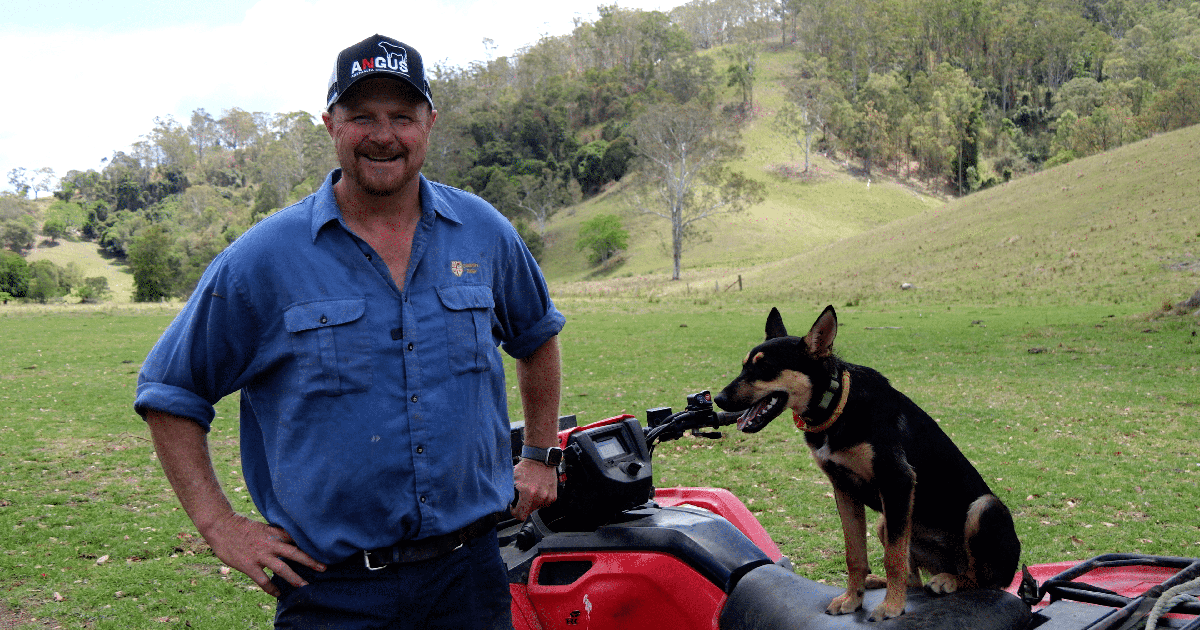

Located on 1,500 acres in the Gloucester region of New South Wales, ‘Merewether’ is operated by Jamie Andrews, alongside his wife and two children.
Running around 300 cows in a self-replacing herd, the ‘Merewether’ business primarily revolves around a feeder steer program, with the steers then finished on a property located nearby.
Since coming into the business twelve years ago, Mr Andrews has overseen the progression of the business from a bullock operation, with the inclusion of Limousin and Hereford bloodlines, to the slow inclusion of Angus influence, which started with the gradual introduction of Angus cows into the operation. Since this began, the percentage of Angus cattle in the herd has increased, and currently sits at about 80%.
Of the choice to integrate Angus genetics into their operation and why, Mr Andrews said, “Genetic diversity. There are so many different Angus sires out there which can cater for many different markets, and we can be pretty specific with where we want to go with ours, so that diversity is really beneficial.”
As per the markets the ‘Merriweather’ herd feed into, Mr Andrews provides feeder steers into JBS Caroona Feedlot at 450kg, selling around 200 head a year through this program.
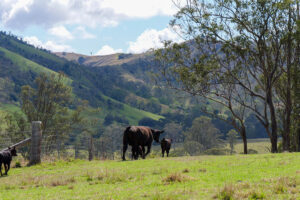 Considering the female herd is self-replacing, each year around 20-40% of heifers are retained back into the mob, with the remaining heifers sold through the local market. Cull cows from the herd are sold through to local abattoirs at Wingham.
Considering the female herd is self-replacing, each year around 20-40% of heifers are retained back into the mob, with the remaining heifers sold through the local market. Cull cows from the herd are sold through to local abattoirs at Wingham.
When selecting genetics for their operation, Mr Andrews is searching for bulls that serve a result for the dual purpose of getting females back in calf and having maternal traits for their replacement heifers, and producing progeny that hits the requirements for their feeder steer market.
“In an Angus bull, you’re probably looking for about five traits,” said Mr Andrews.
“600-day weight is very important to us, as is IMF. Fat content and scrotal size helps as well with the bulls and all of that is leaning towards a dual purpose in regard to getting females that will go back in calf because we retain them, but also trying to hit that feeder steer market.”
He continued, “With the heifers, calving ease is a huge thing that we do require. Not so much with the cows because if they have a calf, they go through into the herd.
“If they have any calving issues, we cull them as a heifer, which assists us in maintaining an improvement in calving ease.”
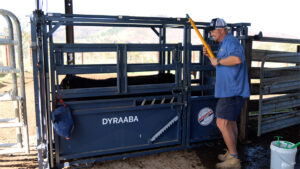 The female herd at ‘Merewether’ serves as a cow cooperator herd in the Angus Sire Benchmarking Program. Through this involvement, 150 cows and heifers from the ‘Merriweather’ herd were Artificially Inseminated (AI) over a ten-day period in 2023 to sires from Cohort 14 of the program.
The female herd at ‘Merewether’ serves as a cow cooperator herd in the Angus Sire Benchmarking Program. Through this involvement, 150 cows and heifers from the ‘Merriweather’ herd were Artificially Inseminated (AI) over a ten-day period in 2023 to sires from Cohort 14 of the program.
“To be a part of the ASBP is a bit of an honour to able to contribute to the improved benchmarking program for Angus Australia,” said Mr Andrews.
When asked about the benefits for him as a producer to be involved as a cowherd in the ASBP, Mr Andrews said, “I think there’s certainly genetic improvements that we should get through our heifers.
“The ability to look at different studs and their bulls and actually see that firsthand, how those animals reproduce, how they hit the ground, how they develop through our heifers and that can help us make decisions into the future with our own breed lines and where we want to improve.”
When it comes to the breeding philosophies and management practices undertaken at ‘Merewether’, Mr Andrews said the following, “In the management of our herd, we use rotational grazing. I find that very beneficial in recovery of the plants and certainly helps your soil ground covers improve.
“Genetically, we’re looking for probably higher IMF in the cattle. That certainly helps at the feedlot stage and also with conception rates in this country, which is just a little bit harder to get things fattened on.
“We look to use about 30 cows to one bull and once again, look for that high IMF and certain other traits that we chase in the youngest gene pool.”
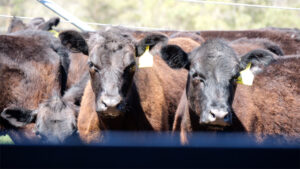 When looking at what they identify as success within their herd, Mr Andrew’s highlighted the key drivers of production for the ‘Merewether’ operation.
When looking at what they identify as success within their herd, Mr Andrew’s highlighted the key drivers of production for the ‘Merewether’ operation.
“The key driver for us are cows in calf. If you can keep above 90%, that is probably the main driver of production and income in us for our business, so that’s really important.
“To do that it’s needling all your cows at the right time, doing the drenches and maintaining good animal health with our cows and heifers,” he said.
“The other key driver is finishing those feeder steers at around 15 to 18 months and getting them right, which is something we continue to work on.”
The landscape of the ‘Merriweather’ property is made up of quite acidic country. The grey loam soil on ‘Merewether’ is approximately three inches of topsoil and bedrock underneath. Due to this makeup, the pasture type requires some further attention, with lime used to counter the acidity found in the soil.
Mr Andrews highlighted that environmental challenges impact their operation alike many in the industry, however emphasized the importance he now places on preempting unfavorable production conditions and implementing strategies to assist in countering, where possible, the negative impacts on his business.
“Everyone’s been impacted by the drought, particularly the 2019 drought, but this year has been a bit stiff as well. We’ve had of six months with 35mm, so it’s been difficult,” he said.
“However, it’s about planning for that, and we implemented a drought plan early on which was getting rid of any latent cows, selling steers early and opening up a few opportunities to put cattle in different properties through agistment, all which has worked well.
“Also, we are feeding cattle at the moment in our spring herd who are calving down or have calved down just recently. Water can also be an issue, but we’re certainly trying to shore that up with pump systems and some big dams.”
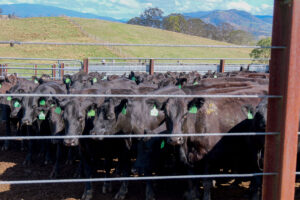 Looking to the future of the ‘Merewether’ business, business growth and genetic improvement is what Mr Andrews will be striving for.
Looking to the future of the ‘Merewether’ business, business growth and genetic improvement is what Mr Andrews will be striving for.
“I’d like to see our business in the future get up to around 400 head and continue with the feeder steer market,” said Mr Andrews. “I find that a very profitable part of the business.”
“Also, I would like to continue improving our reputation within the district, so that people see us to have high quality heifers, high quality steers to sell, and people will chase after them through reputation, through good genetics, and through good farm management that people can see.”
When reflecting on the role he has in the industry and what everyday brings him, Mr Andrew had some excellent concluding words.
“The best part of the job is just being in the environment that we live in,” he said.
“It’s a beautiful part of the world. I enjoy being outdoors and am always spending as much time as I can outdoors so that’s the best part. And just seeing genetic improvements in your cattle.
“Stressful days are when you’re doing preg testing, but when you have a good day, it’s fantastic as well.”
Cheyne Twist, Senior Marketing and Communications Officer